
Rip's Tips - General Discussions  |
Other tip pages: general comments | rigging | settling in | fixing stuff | gadgets | discussion
This particular tip page highlights discussions on a few general topics...
Rip's Driving Tips - Chine Walk & Speed Formula
Chine Walk
An inexperienced boat driver may encounter something new often called "chine walk" as they max rpm's on their new high performance boat. A chine is the intersection of the bottom and side of the boat. A pad is a raised flat running surface on the bottom of some performance bass boats, usually in the middle. As boat speed increases, water contact shifts from the sides and entire bottom to just part of the bottom, like a pad.
Take some time to learn about how small-pad-hull-designs touch the water less at speed, how your Triton balances on its performance pad, and how several factors affect that balance. Here are a few:
Pad-balanced at high speed, "chine walk" may be used to describe falling off a pad, flopping toward a side (chine) and back. The boat suddenly feels like it has a dangerous uncertain wobble instead of having that solid straight-line grip on the water. Sound scary at high speed? Well duh.
Driving On The Pad
Remember, you don't have to put a throttle all the way down and hold it there, whether it's your car, your motorcycle or your boat. Gain your new high speed boat driving skills gradually with practice.
Let me digress... A few months after I bought my Triton, I watched some great boat races on tv with big performance race boats driven by experienced drivers. It's terrifying to watch one of these 90-120mph boats suddenly wobble and flip, or to see them enter a turn with the trim a hair off and "hook" with the back sliding around until the boat makes a hard 90 degree turn or worse a 180 or 360 degree spin ejecting drivers or passengers. I recently saw one scene where the boat simply caught one of thousands of similar waves just a little different, the camera in the boat showed the starboard side with the driver barely moved but the port side jumped up abruptly. The passenger shot up and out like an ejection seat.
To continue... Falling off pad (chine walk) is also affected by water conditions and your driving. There are water conditions where pad speeds are reckless. Plus, the foremost warning to inexperienced performance drivers is "not" to try to drive through chine walk behaviors. You'll likely injure yourself or others. I had thirty-five years boat driving experience but I was an inexperienced performance driver. I learned better driving skills by repeatedly slowing back down when it started to feel unsafe and accelerating again after making one small adjustment at a time. Don't feel embarrassed, each boat has a different feel.
I can't easily explain to someone in words how to simultaneously pedal forward and steer their bicycle to stay balanced and not wobble all over the place. Similarly, I can't put into words all the sensations and slight corrections I'm making with my boat steering, motor height and trim to achieve and sustain balance on a smaller pad. Having learned it, I decided I prefer to drive at slower speeds.
I might simply say these two things... one, I'm not driving through chine walk but driving with anticipation before an out-of-control chine walk behavior manifests, and, two, I had to "unlearn" how I drove my dual console '89 Skeeter and relearn to run with my motor "significantly" higher vertically on the jack plate (mindful of water pressure) and with "a lot less" motor trim for bow lift to arrive at optimum running attitude on my TR21.
One more thought... when you fell off your bike, your mother could kiss your scraped elbow to make it well and help you straighten your handle bars to try again, however mom's kisses and helpful touch won't undo losing control of your boat at high speed. Think about it. Take your time. Learn in little steps. Be apprehensive.
Getting Advice
Far from expert about setup and racing, you can tell that I listen to my dealer's service tech, Mike. I also monitor contributor's at BFHP boat/motor message board. Here's some patient advice from a BFHP discussion thread on "chine walking" repeated to help you or your dealer if your boat displays a tendency to "walk":
| "9/8/99 6:24:00 PM Ben H (205.188.197.188) from TENNESSEE says
Remedies for chine First no anger at all, just amazed when the thread
continues on and on in error.
Getting rid of chine walk takes time and patience, but MOST of the time it can be done. I start with determining if the engine is on the boat in perfect plumb with the outside chines at the transom. This is done by leveling the boat on the trailor by checking level from outside of chine to out side of chine. Then I check the level of the top of the jackplate, Next I check to see if the "mounting claws" of the engine are perfectly level with the jackplate. If any thing is out of plumb or out of level it is adjusted. I then raise the engine 1/4 inch at a time till I start to lose water pressure, drop it about an 1/8 inch from that highest point and proceed to prop the boat for the best performance I can get with everything plumb. I may shift the weight around in the boat, via batteries, oil tank etc. Then if the chine persists, I raise only the drivers side of the engine by 1/8 inch and trial run again. I may raise it an additional 1/8 for a total of no more than 1/4 inch. I am on purpose, making an out of plumb condition to offset the torque of the prop. By tilting the top of the motor to the left, you in effect lower the right side of the boat, (or raise the left side, whichever you prefer) which causes the torque of the prop to lift more weight before chine walking can begin. Almost always, but not in all cases, this will fix a chine walking boat. But don't do the out of plumb adjust first......ALWAYS start with engine height and prop selection. The more cup in a prop, the less it will cause chine walk, especially if it is a 4 blade. You must be willing to invest the time, energy and possibly money for the best prop for your rig. And you must make good notes and test run after each change made. DO NOT make a bunch of wholesale changes and then water test, you will get lost real fast." |
This is just a sample of the type of technical advice available from contributors. There's a link to BFHP message board on my links page.
The Triton Owners Page has a variety of advice toward the bottom of the page under all the photos.
Ken Cook has useful advise on driving at http://www.kencook.net/Chinewalk.html
Theoretical Speed Formula
A few variables apply in this quest for water skimming speed. Set up right, prop tuned in, motor height dialed up, trimmed just so, that Triton flies on that little performance pad. You draw on driving experience to keep a Triton balanced there even after the boat's set up right.
Boats can go fast. Let's look at a theoretical speed formula published as an answer to a question in the July/August '99 edition of Bass & Walleye Boats Magazine. Great magazine!!! Their speed formula is:
|
(rpm) x (gear ratio) x (prop pitch) x (constant) = theoretical max speed multiply that by .9 for average slippage of ten percent, yours may be more/less |
Now, whack that against my TR-21 power-train setup. They use 0.0009469 as the constant in their formula. I have a 1.75:1 gear ratio on my Merc 225. That calculates to 0.5714285 (1 divided by 1.75). The Merc 225 max rpm range is 5200-5800 pushing that 25 pitch prop. Here goes...
5800 x 0.5714285 x 25 x 0.0009469 = 78.457 mph
average slip .9 x 78.457 = 70.6 mph
or more realistically for me...
5200 x 0.5714285 x 25 x 0.0009469 = 70.34 mph
average slip .9 x 70.34 = 63.3 mph
Triton Mike shared a calculator web link using same formula including slip
http://www.calculator.com/calcs/calc_bassboat.html
Here's some others...
http://www.rbbi.com/folders/prop/propcalc.htm
http://members.aol.com/ejoejr/PropAnalyzerAppletG.html
http://www.kencook.net/BBF.html
For a good explanation on pitch, that mysterious thing called slippage, or cup, rake, and so
on, try...
http://www.boated.com/how/props.html
To go faster, change the variables... up prop pitch without lowering max rpm's, or minimize slip.
But hey, I personally don't wanna. Tweaking setup and pushing limits of the small high performance pad is there for some Triton drivers, like a younger Ray. Other dialed-in TR-21s can just blow past me. The older Ray stays within an envelope that gets me safely to and from my fishing hole during tournament hours.
Yeah, mine is probably the Triton boat that some guy driving another brand brags about leaving behind on the lake, sneering about how slow Tritons are.
Believe it or not,
I was going real-l-l-l-ly slow
when I caught this bass
Well boys and girls, you go get 'em. My Triton TR-21 does just fine and is a true pleasure to drive without WOT (wide open throttle) and high performance driving. There's something there for each of us. The Triton is a versatile design. I bought mine for fishin' comfort as you can see.
 back to discussion tip list (top)
back to discussion tip list (top)
Rip's Lookin' For Leaks - a step-by-step
My new Triton TR21 showed some unexpected water in the bilge. My friends' TR21s didn't, absolutely no leaks at all. Triton's great customer service kicked in quick to get mine fixed at my dealer. I wanted to help pinpoint them if I could. It's just my nature to poke around and try to solve stuff. Over a month or so, I picked up lots of tips from BFHP readers and guys trouble-shooting various brands of boats for leaks while parked at boat launches. I assembled those and adapted them into a step-by-step to fit my '99 TR21.
I'm not first-hand familiar with Triton's water tank test as used at the beginning of '99. It's a good quality-control idea. I think potential leaks that might slip past that test are:
If you encounter unexpected water in the bilge of a new TR21, suspect these first. Other leaks, lower in the plumbing, should show in their tank test, suspect those last. Don't forget the ice chest drains to the bilge, that water isn't a leak.
Here are general step-by-step leak discovery procedures, presuming you didn't puncture your hull on a stump:
|
If your possible leak has not appeared yet, get real suspicious about your partner's water jug in that back storage compartment or figure your water is coming from the ice chest. Actually, if the water wasn't that rough, we haven't ruled out the bolts behind the front bow-eye or that 8-foot wave you sometimes spear. See, there's always somethin'.
Good luck. Small leaks seem rare in Tritons, but if you just happened to get one with some, perhaps these tips help you or your dealer pin that drip down quick.
 back to discussion tip list (top)
back to discussion tip list (top)
Loading on Trailer - Big Merc Bogs Down
Here's a clip of a response I gave to a reader on one of the message boards on yet another question about how to power the boat up onto the trailer when the Mercury motor seems to bog down at 2000 rpm and won't push the boat a foot or so for boat's bow eye to reach trailer bow stop.
| "If that efi you mentioned is a Merc like mine, you experience what I have the
past couple years.
When I under-pitched the prop as an experiment, the Merc could finally push that big boat onto the trailer like I was used to with my old Yamaha powered rig. I asked questions about this way back when and heard similar hard-to-power-load experiences from friends with Merc 225 EFIs. I'd rather run my 25 pitch Trophy than under-prop it, so I've learned to be way Way WAY more exact when backing down than I used to be with my old rig. I still miss it by an inch or so every once in a while. Some folks at the ramp or your buddies won't understand that you now have a problem and will suggest you simply back in farther or less, well yeah, but which of course varies depending on the slope of the ramp. So, it's not the same all the time, and with the Merc's oomph, how much farther or less may have to be adjusted down to an inch or two in distance. Not the half-foot or foot or so backing-up slack most people are used to. Practice on different slope ramps when no one else is loading/unloading until you know just how far to wet some area in front of or on your wheel wells for the different launch slopes or lake wave conditions. I power-loaded for years, but had to relearn given this Merc's characteristics. My older MFI style trailer has a step-pad in front of the tandem wheel well. I eyeballed how far it is into the water as a beginning clue. Here's how I learned more... When I practiced, as I was launching, if I was backed in to where I just struggled to pull the boat off the trailer with the motor to launch it, not powering off easy, not practically sliding off, but struggling a bit, that was likely very close to the spot I'd need to be at to power it back on. Any further in when reloading, I'd slide back off the bow roller or nose under it, any less the Merc usually gave up a foot or so from the roller. Now look at where that step pad is in the water for that slope ramp. You'll start to get an idea of the inch or two more or less to back in. Practice putting it back on. Did it nose under, slam on, give up too short? Adjust a little, try again. The next thing you should begin to notice from ramp to ramp is the change-of-depth or "angle" of the water over something like the front or middle of the step pad to its back or from one wheel well to the next. That angle hints at a ramp's slope, and you'll begin to notice you put something like the step pad further under or out of the water based on that angle. That's right, you don't just back it down to the same spot you figured on a shallow ramp when you get on a steeper ramp. Waves and rough water may mean another very slight adjustment where you back in an inch or two less. Practice. Hey, I also switched to a Stoltz bow stop roller to minimize the black marks in front of the boats bow ring, better cushion effect too. Hope this helps. -rip" |
 back to discussion tip list (top)
back to discussion tip list (top)
Changes - Some Differences Between '99 and '01 TR21's
I stopped by to visit with Mike Witt and his service tech, Mike VanNatta, at Witt Marine. They were setting up a new '01 TR21 DCP in a service bay. They welcomed me to take pictures of the new model and make comparisons between it and an older one next to it.
The most obvious change in a newer TR21 on paper is that it's a true 21' instead of 20' 6". The new models look similar to my old one, so what did they do with the extra 6".
Well, for one thing, Triton responded to one of my suggestions that we need to be able to check all cells in our batteries without rearranging them in the back compartment. Mike confirmed that the new compartment now lets you and your dealer more easily install and arrange batteries, oil reserve, battery charger and spare prop.
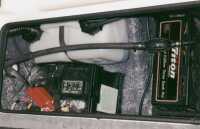 |
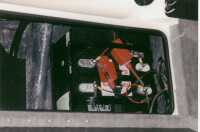 |
| above - battery compartment starboard side |
above - battery compartment port side |
note: click any photo to link to a larger image
I could see when looking inside the '01 TR21 DCP that there's now enough room behind the starting battery to install the large oil reserve. The huge triple bank charger can be mounted on the metal floor plate with room left over for a spare prop. On the other side, I saw where there is room for securely mounting the trolling motor batteries where you can easily observe cells for proper fluid levels or access reset breakers on the wiring.
Moving forward, I looked over differences between my '99 dual consoles, which are molded into the cap, and the new modular consoles on this '01 dual console TR21. They are now separate from the cap which enhances construction techniques.
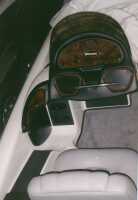 |
 |
| above - console on port side |
above - console on starboard side |
Looking to port, I noticed the passenger rod rack is laid out lower than before with a foot brace for passenger comfort. Looking to starboard, I saw where the rotary switches, formerly on a flat panel along the gunwale, are now placed closer to positions of your hands on the steering wheel.
A large flat area to the right of my '99 model driver console is convenient for mounting accessories like a GPS, a panel-screen depth finder, and a compass. This area is now a small sweeping curve (with you go-fast boys and girls in mind). Seems like you can just barely mount one thing there now. Mike pointed to the Johnny Ray swivel mount with a small foot print which he is using to adapt larger bases of traditional electronic fishing accessories to this tiny area.
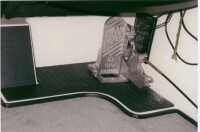 |
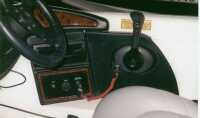 |
| above - looking under driver console |
above - looking at gunwale on driver side |
I saw something very different as I settled into the driver console... below there is foot brace with a secure mounting platform for the foot throttle. The shifter on this one looked different than mine, and the driver glove box appeared lower.
reminder: click any photo to link to a larger image
 back to discussion tip list (top)
back to discussion tip list (top)
State Fuel Tax Refund For Off-Road Use (Boating)
Because half my fuel purchases here in Texas are for boating, I've taken advantage of Texas fuel tax policies for off-road use. I keep separate detail receipts for my boat fuel purchases. The reason becomes apparent as you read this bonus tip for you Triton owners here in Texas.
Texas residents interested in learning more about fuel tax refunds can refer to the State Comptroller of Public Accounts "The Fuels Tax" page http://www.window.state.tx.us/taxinfo/fuelstax.html where some of this is explained as follows under frequently asked questions...
"How can a person get a refund of the tax on fuel used in off-road equipment? To request a refund of the tax paid on fuel used in off-road equipment use Comptroller form 06-106. A refund request must be postmarked no later than one year from the first day of the calendar month following the purchase or use of the fuel."
"The Fuels Tax" page also points to the state's "Tax Forms On-Line" web page for Texas Motor Fuels, Interstate Trucker, and IFTA Report Forms. More specically, yielding a pdf file at: http://www.window.state.tx.us/taxinfo/taxforms/06-106.pdf
The instructions for claiming refunds are briefly explained on the second page of this form and refer to certain Motor Fuel Tax Rules. "The Fuels Tax" page also has a link to those rules for more detailed information about qualifications, restrictions or records.
 back to discussion tip list (top)
back to discussion tip list (top)
Return to Rip's Triton Tips main page.
Also consider exploring BBC Home Page for Bryan Bass Club information and links to other bass fishing/boating sites.
Ray's Triton Page | Buying Adventure | Area Dealers | Rip's Triton Tips | Other Links | BBC | Ripstips Home
For corrections on this page series, please contact Ray Rippstein at r-rippstein@tamu.edu
Thanks for visiting.
This intro page last updated July 3, 2006